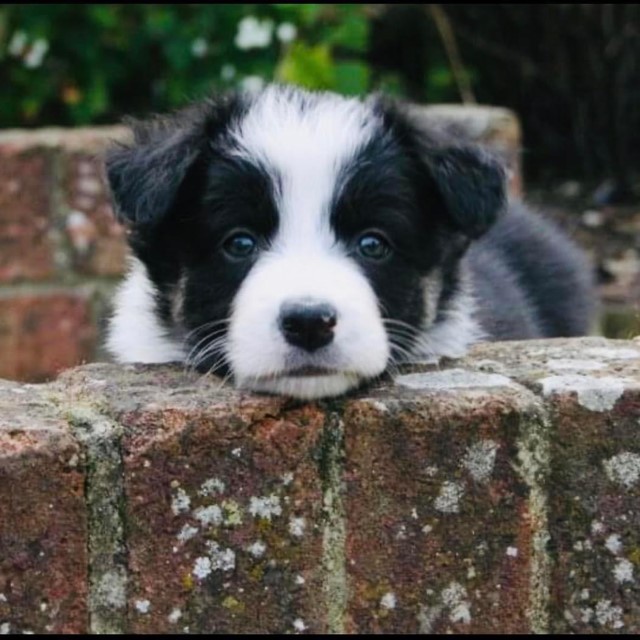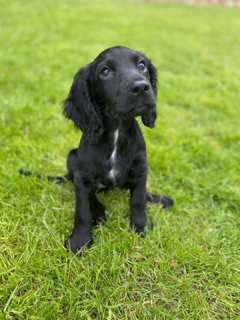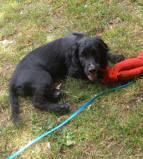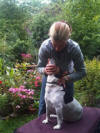Be puppywise...
 Getting
a new puppy for agility can be really exciting, but it's to keep in mind
that, along with all the fun and excitement of training a new dog, we have a
responsibility to ensure that it grows into happy and healthy adult.
Canine and equine Chiropractor Petra Langen-Pieters wrote this article for her
Equine & Canine newsletter, reminding
people how important puppy development is. Getting
a new puppy for agility can be really exciting, but it's to keep in mind
that, along with all the fun and excitement of training a new dog, we have a
responsibility to ensure that it grows into happy and healthy adult.
Canine and equine Chiropractor Petra Langen-Pieters wrote this article for her
Equine & Canine newsletter, reminding
people how important puppy development is.
Our first
obligation is to make sure that our puppy gets the correct nutrition and exercise to
allow it to grow into a
happy and fit dog regardless of whether they do agility or not.
One critical aspect of a
puppy's health is the skeletal system which is fundamentally different from that
of an adult dog. By understanding how a puppy's skeletal system works, you can
ensure they get what they need at the right time for growth and development.
Growth plates
The long bones have areas called physis or growth plates that are
made of cartilage, which turns into bone as the puppy grows, leading to an
increase in bone length. Once the bone reaches adult size, the growth plate
closes, and any damage to the growth plate can cause premature closure, which
can be a problem if the puppy has not yet reached his adult size.
The rate at which a
puppy's growth plates close depends on whether he is a small breed or a large
breed dog. The growth plates of bones in small breeds begin to close from about
three months of age and usually all close by 12 months of age. In contrast, the
growth plates of bones in large breeds only start to close at about five months
of age and may take up to 18 months to close entirely. These closed growth
plates (or physeal lines) can be seen on an X-ray.
 Nutrition Nutrition
Because large breed puppies take longer to reach skeletal maturity,
it's crucial to feed them the correct diet until at least 18 months of age,
after which they can switch to an adult diet.
Feeding your puppy a
diet formulated for their age and breed is vital, since puppies require a higher
level of minerals and nutrients as their bodies are still growing. Calcium and
phosphorus are two of the most important minerals for bone health, and their
ratio is critical. If a large breed puppy's diet has an incorrect ratio, it can
lead to long bones growing too quickly, weakening both the bones and the joints.
Hip dysplasia is
hereditary and is especially common in larger dogs, like the Great Dane, St.
Bernard, Labrador Retriever and German Shepherd. Factors such as excessive
growth rate, types of exercise, improper weight and unbalanced nutrition can
magnify this genetic predisposition.
Specially formulated
diets for large breed puppies help prevent excessive growth, which can lead to
skeletal disorders such as hip dysplasia, elbow dysplasia and other joint
conditions. Slowing down these breeds' growth allows their joints to develop
without putting too much strain on them, helping to prevent problems down the
line.
Obesity puts a lot of
stress on your dog's joints, which can also exacerbate a pre-existing condition
such as hip dysplasia or even cause hip dysplasia. To keep your puppy's bones
healthy and strong throughout his life, you should feed him the correct diet
according to his age and breed. Feeding it the correct quantities and ratios of
high-quality nutrients (proteins, minerals and carbohydrates) that its breed
requires, is essential.
 Activity levels Activity levels
Starting agility exercises too soon can lead to trauma in the growth
plates again exacerbating genetic predisposition to developmental joint issues
as well as affecting normal growth in all puppies. It's crucial not to expose
your puppy to too much strenuous exercise before he reaches skeletal maturity.
Veterinarians recommend training small breed dogs from a young age to use steps
to climb onto and off furniture to avoid fractures. Exercise is essential for
puppies though, but it should be done in moderation and using the right
techniques. By understanding how to exercise your puppy correctly, you can help
it build strong, healthy bones.
There are a few things
you can do to keep your puppy safe while they're exercising:-
-
Limit high impact exercise such as
jumping, twisting and skidding.
-
Keep exercise sessions short and allow
them to rest as much as they need.
-
If you notice them getting tired but not
stopping to rest, pop them on their lead and take them out of the situation
to recover for a few minutes.
-
Cover any slippery floors in your home to
protect their joints.
-
Avoid long walks, hikes and activities
such as running and cycling until they are fully grown and always build
their fitness up slowly.
 About
the author About
the author
Petra Langen-Pieters
BHSAI EBW DC has studied Chiropractic extensively and, in addition to being a Doctor of
Chiropractic, she holds an Honours Degree in Animal Science from Nottingham
University. Her training in Animal Chiropractic was completed in America with
certification by the American Veterinary Chiropractic Association. She also has
certification by the International Veterinary Chiropractic Association and the
British Veterinary Chiropractic Association.
She is also a
Chiropractor for people.
Petra is based at the
Addlestone Chiropractic Clinic in
Addlestone, Surrey but can travel as far as Berkshire, Hampshire,
Buckinghamshire, Hertfordshire and West Sussex.

For more information,
ring Petra Langen-Pieters on 07787 514271 or 01932 857782.
Feedback
Sunnie De Pass
Instructor PDTI
Over the past nine years that I have been running Puppy Fundamental and
Obedience classes, one of the questions I’m most asked about is exercise. How
long can I walk my puppy at 12/16 weeks etc? How do I tire my puppy out? It has
so much energy. Something as fundamental to a pups’ needs as exercise and the
impact of overdoing the walks, running with puppies and rewarding the jumping
up/standing onto their back legs can have an impact on their soft growing
skeletons.
So many
people who come to my classes are not aware of the 'five minute rule' - five
minutes exercise for each month. Many will walk 10 minutes to the local park,
watch their pup run about for 30 minutes or so and then walk them home again.
Some will ask me “Why does my puppy just sit down on the road, on zebra
crossings etc when we are out walking? The simple reply of 'your puppy is tired,
you’ve over walked him/he' often brings a look
of puzzlement as they begin to realise the limitations, their pups’ needs and
their human expectations.
Sunnie De
Pass runs Archway Dogs in London.
Photo credits:
Sunnie De Pass and Maria Johnston
First published in Equine & Canine
Summer 2024 newsletter
Kindly reposted with permission of the author on 9th September 2024
|